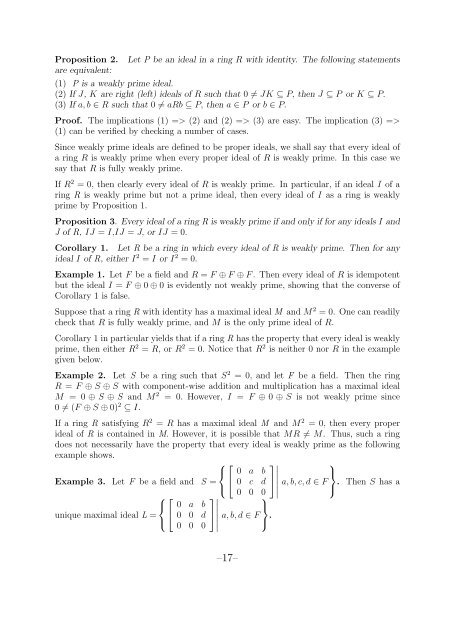Yasuyuki Hirano, Edward Poon and Hisaya Tsutsui
Yasuyuki Hirano, Edward Poon and Hisaya Tsutsui
Yasuyuki Hirano, Edward Poon and Hisaya Tsutsui
Create successful ePaper yourself
Turn your PDF publications into a flip-book with our unique Google optimized e-Paper software.
Proposition 2.<br />
are equivalent:<br />
Let P be an ideal in a ring R with identity. The following statements<br />
(1) P is a weakly prime ideal.<br />
(2) If J, K are right (left) ideals of R such that 0 ≠ JK ⊆ P, then J ⊆ P or K ⊆ P.<br />
(3) If a, b ∈ R such that 0 ≠ aRb ⊆ P, then a ∈ P or b ∈ P.<br />
Proof. The implications (1) => (2) <strong>and</strong> (2) => (3) are easy. The implication (3) =><br />
(1) can be verified by checking a number of cases.<br />
Since weakly prime ideals are defined to be proper ideals, we shall say that every ideal of<br />
a ring R is weakly prime when every proper ideal of R is weakly prime. In this case we<br />
say that R is fully weakly prime.<br />
If R 2 = 0, then clearly every ideal of R is weakly prime. In particular, if an ideal I of a<br />
ring R is weakly prime but not a prime ideal, then every ideal of I as a ring is weakly<br />
prime by Proposition 1.<br />
Proposition 3. Every ideal of a ring R is weakly prime if <strong>and</strong> only if for any ideals I <strong>and</strong><br />
J of R, IJ = I,IJ = J, or IJ = 0.<br />
Corollary 1. Let R be a ring in which every ideal of R is weakly prime. Then for any<br />
ideal I of R, either I 2 = I or I 2 = 0.<br />
Example 1. Let F be a field <strong>and</strong> R = F ⊕ F ⊕ F . Then every ideal of R is idempotent<br />
but the ideal I = F ⊕ 0 ⊕ 0 is evidently not weakly prime, showing that the converse of<br />
Corollary 1 is false.<br />
Suppose that a ring R with identity has a maximal ideal M <strong>and</strong> M 2 = 0. One can readily<br />
check that R is fully weakly prime, <strong>and</strong> M is the only prime ideal of R.<br />
Corollary 1 in particular yields that if a ring R has the property that every ideal is weakly<br />
prime, then either R 2 = R, or R 2 = 0. Notice that R 2 is neither 0 nor R in the example<br />
given below.<br />
Example 2. Let S be a ring such that S 2 = 0, <strong>and</strong> let F be a field. Then the ring<br />
R = F ⊕ S ⊕ S with component-wise addition <strong>and</strong> multiplication has a maximal ideal<br />
M = 0 ⊕ S ⊕ S <strong>and</strong> M 2 = 0. However, I = F ⊕ 0 ⊕ S is not weakly prime since<br />
0 ≠ (F ⊕ S ⊕ 0) 2 ⊆ I.<br />
If a ring R satisfying R 2 = R has a maximal ideal M <strong>and</strong> M 2 = 0, then every proper<br />
ideal of R is contained in M. However, it is possible that MR ≠ M. Thus, such a ring<br />
does not necessarily have the property that every ideal is weakly prime as the following<br />
example shows.<br />
⎧⎡<br />
⎨<br />
Example 3. Let F be a field <strong>and</strong> S = ⎣ 0 a b<br />
⎤<br />
⎫ ⎬<br />
0 c d ⎦<br />
⎩<br />
0 0 0 ∣ a, b, c, d ∈ F . Then S has a<br />
⎭<br />
⎧⎡<br />
⎨<br />
unique maximal ideal L = ⎣ 0 a b<br />
⎤<br />
⎫ ⎬<br />
0 0 d ⎦<br />
⎩<br />
0 0 0 ∣ a, b, d ∈ F ⎭ .<br />
–17–















